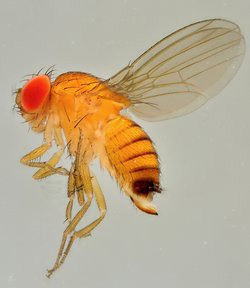D. suzukii has been reported so far in most of the Mediterranean countries in Europe and is rapidly spreading toward north and east. In most attacked countries D. suzukii caused extensive economic damage to small fruits; for this reason, and because efficient monitoring and control tools are not yet available for this species, growers and producers at the Trento (Italy) meeting pushed for immediate and efficient solutions.
 D. suzukii adults are drosophilid flies (2-3 mm long) with red eyes, a pale brown or yellowish brown thorax and black stripes on the abdomen. Sexual dimorphism is evident: males display a dark spot on the leading top edge of each wing and females possess a large serrated ovipositor.
D. suzukii adults are drosophilid flies (2-3 mm long) with red eyes, a pale brown or yellowish brown thorax and black stripes on the abdomen. Sexual dimorphism is evident: males display a dark spot on the leading top edge of each wing and females possess a large serrated ovipositor. In the picture: D. suzukii Female (Photo: S. Revadi e A. Lucchi).
D. suzukii is currently spreading in many areas, such as the USA (West and East coast), Canada, Mexico and Europe (Spain, France, Italy). By 2010-2012, the range of D. suzukii was further enlarged. In Italy it was reported in several other regions: Piemonte, Lombardia, Veneto, Emilia Romagna, Liguria, Marche, Calabria, Campania and Sicilia and in France it was found from Corsica up to Ile de France.
Then, many other European countries made their first record: Switzerland, Slovenjia, Croazia, Austria, Germany and Belgium. It appears to be spreading rapidly and all of continental Europe is at risk for invasion; the ecological simulations indicate the northern humid areas as more suitable ecosystems compared to the Mediterranean drier environments, especially because desiccation seems to be a limiting factor for drosophilids.
Most damage caused by D. suzukii is due to larvae feeding on fruit flesh, however the insertion of the prominent ovipositor into the skin of the fruit can cause physical damage to the fruit, as it provides access to secondary infections of pathogens - such as fungi, yeasts and bacteria - that may cause faster deterioration and further losses.

Damages caused by D. suzukii on various fruits. (Photo: A. Grassi).
Additional costs are related to increased production costs related to pest control (monitoring and chemical input costs, increased labour and fruit selection, reduction of the fruit shelf life, storage costs) and to the decrease of foreign market appeal for production from contaminated areas.
Adults of D. suzukii reach maturity one or two days after emergence (during the warm season). Mating occurs from the first days of life and females start to oviposit already from the second day from emergence. Females typically lay 1-3 eggs per fruit in up to 7-16 fruits per day; since they are able to oviposit for 10-59 days, they can lay up to a total of 600 eggs during their lifetime (around 400 eggs on average). This very short generation time implies that D. suzukii can complete several generations in a single cropping cycle and up to 7 to 15 generations in a year, according to the specific climatic conditions, thus allowing an explosive population growth.
The ability to survive and reproduce in a wide range of climatic conditions is obviously a relevant factor for insects. Limiting temperatures for D. suzukii reproduction are between 10 °C and 32 °C for oviposition and up to 30 °C for male fertility. The peak of activity and development is around 20 to 25°C. D. suzukii can thus be considered a species with high thermal tolerance, being both heat tolerant (viable D. suzukii populations resist to the hot summers in Spain) and cold tolerant (D. suzukii is present in cold areas, such as mountain regions in Japan and Alpine areas).
D. suzukii is able to develop on a very wide range of both cultivated and wild soft-skinned fruits with many host plants in the native and in the invaded areas, with berries being the preferred hosts. The wide host range represents a pest management constraint not only because D. suzukii can cause damage to many species, but also because populations can survive almost everywhere, alternating hosts with different ripening times through the year, both cultivated and wild.
D. suzukii has a high dispersal potential, which would seem to be confirmed by its rapid spread in invaded countries and its presence on several continents, as well as remote islands. According to a preliminary study, the estimated costs due to D. suzukii impact were in Trento province (Northern Italy), whose area is devoted to small fruit cultivation (about 400 hectares), around 500,000 € in 2010 and 3 millions € in 2011.
The rapid spread of the invasive fruit pest D. suzukii and the increasing losses of production due to the insect have stimulated the Italian Research Group (IASMA Research and Innovation Center Fondazione E. Mach - Dep. Sustainable Agroecosystems and Bioresources Chemical Ecology Research Group, S.Michele all’Adige, Trento) to plan a research program aimed at: 1) the knowledge of D. suzukii basic biology, 2) the development of pest control means, and 3) knowledge transfer and technology implementation.
Original research work. Cini A., Ioriatti C., Anfora G., 2012. "A review of the invasion of Drosophila suzukii in Europe and a draft research agenda for Integrated Pest Management". Bulletin of Insectology, 65 (1): 149-160.
Thanks to: Dr Gianfranco Anfora for the supplied materials.
